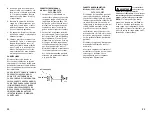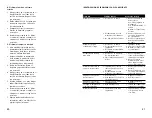
OPERATION OF THE FREESPOOL
MECHANISM
The sound of
grinding gears
while trying to engage the drive,
(taking the winch out of freespool),
is caused by the drive splines being
rotated too quickly to allow
engagement. Use the metering
capability of the directional control
valve to slow the motor rotation
allowing the splines to engage and
slide into full engagement. Do not
continue to power the winch when
you hear the sound of the gears
grinding.
REMOTE FREESPOOL
CONSIDERATIONS
1. Applications which utilize a
mechanical linkage to remotely
activate the freespool mechanism
need to address the following
points in their design and
construction.
a. A positive locking mechanism
which locks the drive in both
the winch or freespool position.
b. If the linkage creates too high
a drag or binds the action of
the winch’s freespool mecha-
nism, a separate spring or
bushings may need to be
installed so that the freespool
clutch will self-engage. The
winch’s freespool spring may
not be strong enough to pull a
heavy or bound linkage into
place.
FAIL-SAFE BRAKE
1. The H11/13/15P winches are fitted
with standard multiple disc spring
applied, hydraulic release, dry
design fail-safe brakes.
2. Use the load rating by layer
found on the product label as a
guide for the brake rating by
layer.
3. A minimum pressure of 300-350
psi is required to fully unlock the
brake.
Do not attempt
to run the
winch at pressures less than 800 psi
(55 bar). The brake will release at
350 psi (24 bar), but the counterbal-
ance valve will not open until 800
psi (55 bar) is reached.
4. The load holding capacity of the
brake is reduced by the back or
return line pressure. IF THE
BRAKE WILL NOT HOLD A LOAD,
CHECK THE SYSTEM FOR EXCESS
BACK PRESSURE. ITEMS SUCH AS
A CRIMPED HOSE OR DIRTY FIL-
TER WILL GREATLY INCREASE
BACK PRESSURE. The back pres-
sure effects must be accounted
for when winching a load.
5. Periodically test the brake by dis-
connecting and plugging the
shuttle valve to brake line. Slowly
apply pressure to the motor.
When the pressure reaches 1700
to 1800 psi, (117–124 bar), the
drum should start to slowly
rotate.
6. Never apply a pressure greater
than 2200 psi (152 bar) to the
brake.
If the drum
starts to rotate
at pressures below 1700 psi (117
bar), the brake is either worn or
requires service.
12
GENERAL PRECAUTIONS
THESE WARNINGS AND PRECAU-
TIONS MUST BE OBSERVED AT ALL
TIMES
.
1. Before installing or operating the
winch read this manual. Do not
allow anyone to operate the
winch until they have read this
manual and received proper
instruction in the winch’s use. If
you do not understand any of the
warnings or instructions call
Superwinch at the number(s)
found in the front of this manual.
2. Do not operate the winch when
under the influence of drugs,
alcohol, or medication.
3. Winch is not to be used for mov-
ing people or anything contain-
ing people.
4. Do not work on or around the
winch with the PTO engaged
and/or hydraulic pump running.
5. Be sure the product, warning,
and rating labels on the winch
are not obstructed.
6. The winch should not be altered
in any way without the written
authorization of Superwinch.
7. Use only factory approved acces-
sories. Non-approved components
may void your warranty and/or
fail under load. Superwinch will
not be responsible for damage or
honor any warranty claim arising
from the use of non-factory
approved accessories and/or
components.
THESE WARNINGS AND PRECAU-
TIONS MUST BE OBSERVED
WHEN SETTING UP, AND/OR DUR-
ING THE WINCHING OPERATION.
1. Inspect the wire rope for kinks
and/or damage before winching a
load. Check all tackle for damage,
proper function, and rating. Use
only tackle whose rating meets or
exceeds that of the winch.
a. Pulley blocks and any attached
tackle must have a working
load rating at least twice that
of the winch.
2. A minimum of 5 wraps of wire
rope must be on the drum before
applying a load to the winch. The
rope to drum attachment will not
hold a load.
3. When moving a load, slowly take
up the wire rope slack until it
becomes taut. Stop, recheck all
winching connections. Be sure all
tackle is properly seated. Check
the wire rope to be sure it is run-
ning properly in any pulleys.
4. If the winch stalls or will not
start the load, do not maintain
hydraulic pressure to the motor.
Break down the set up, install a
pulley block, and use a double
line technique.
5. Do not start and stop loads.
Starting and stopping places an
unnecessary strain on the winch
and may loosen wire rope and
tackle connections.
6. Keep clear of the winch, wire
rope, and the winching operation
itself. Keep people out of the
winching area. Operate the winch
with a clear, unobstructed view of
the winching operation. Always
be aware of potential hazards.
Ask yourself “What will happen if
the wire rope or any tackle
breaks?”
S A F E T Y
I N F O R M A T I O N
13
























